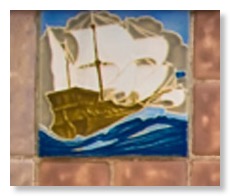E-News for Autumn 2012
12/10/12 11:31 Filed in: E-News
Founded in July 1987 Tile Heritage celebrates its 25th anniversary this year. Supporters like YOU... members, major contributors, industry sponsors, generous grantors... everyone... have made possible the continued fulfillment of the Foundation’s mission to Document and Preserve tile history, both past and present. THANK YOU!
Here’s What’s Below!
Alhambra: A Rare Find!
U.S. Historic Tile Installations
Presumably Gladding, McBean...
Hage’s Ice Cream Encountered
Rookwood: Mission Impossible (nearly)
The Spanish Pottery
Volunteer!
“Living Walls: Albany (NY)”
Payne Creations Chosen
E-News in Print
Here’s What’s Below!
Alhambra: A Rare Find!
U.S. Historic Tile Installations
Presumably Gladding, McBean...
Hage’s Ice Cream Encountered
Rookwood: Mission Impossible (nearly)
The Spanish Pottery
Volunteer!
“Living Walls: Albany (NY)”
Payne Creations Chosen
E-News in Print
Alhambra: A Rare Find!
Initially mistaken for Rookwood, these tiles were made by The Alhambra Tile Company of Newport, Kentucky. Mantel No. 37 and Arch No. 7 consist of the 11 pieces around the top of the fireplace opening. The mantel is illustrated in "Faience Arch Mantels," an Alhambra company catalog.
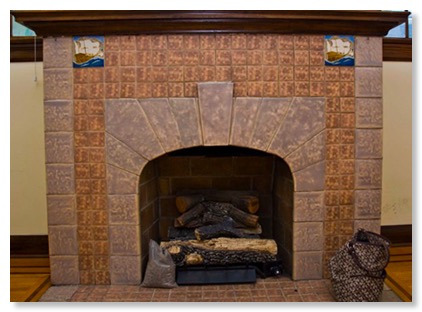
The galleon, No. 695 R, is illustrated in "Artistic Designs of Mantles using Faience and Araby Tiles," another Alhambra catalog published about the same time. Reproductions of these two catalogs are available through the Tile Heritage website. See catalogs
According to Norman Karlson in The Encyclopedia of American Art Tiles, the company was founded in 1901 by Otto Wolf and John Sheehy, with the latter gentleman as superintendent. Concerning the company's products, Karlson remarks that the pottery "was not a follower of all the latest trends." The company closed in 1941 and its facility was leased for war-related work. In 1942 the building burned to the ground and all the tile-related materials in storage were lost.
U.S. Historic Tile Installations
Board member Riley Doty was delighted recently to discover a trove of interesting historic tile material on a website maintained by THF member Michael Padwee of Brooklyn, New York. Riley asked Michael to write a few words about this ever-expanding resource and received this reply:
"About two years ago I discovered the historic landmarks website. The owner encouraged me to start a website about my interest—historic tile installations. I knew of a few installations existing in the New York area, and others that had been destroyed or had disappeared. I decided to research the installations, organize them by state, and share the information I found. One goal of this website is to locate and describe those installations that still exist but may not be well known, publicize them, and bring them to the attention of those who are interested in the preservation of historic tiles. Another goal is to document installations that have been destroyed and publicize the loss of our artistic heritage. I've received positive feedback and information about other installations from website visitors and hope that THF members will help also."
Here is a link to Michael's web site where 65 to 70 tile installations are described thus far. Michael has also started a blog, "Tiles in New York" as an adjunct to the website.
Presumably Gladding, McBean...
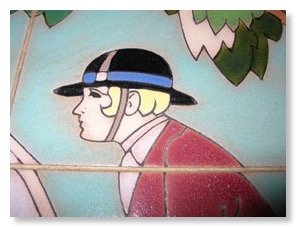
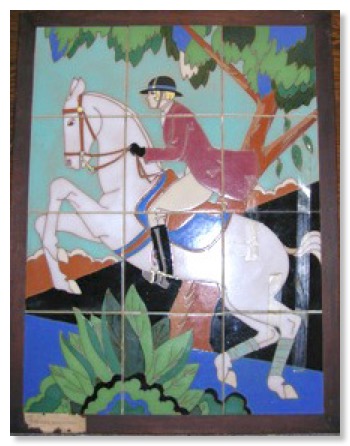
It can be a challenge identifying tiles, a service that we provide free at the Tile Heritage Foundation. Often we have to rely on experts, both collectors and historians, to reach a consensus. In fact, it’s the tiles we DON’T know that make our job interesting! Recently, Jennifer Wood, an estate appraiser in Santa Monica, California contacted us with several tile murals she needed identified. We had our suspicions but needed them confirmed. In this case we relied on the expertise of Steve Soukup and Scott Wells, who both agreed from the glaze colors and design elements that this particular equestrian was produced at the Gladding, McBean manufacturing plant on Los Feliz Boulevard in Glendale, formerly Tropico Potteries.
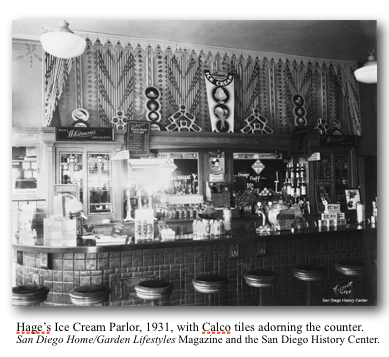
Hage’s Ice Cream Encountered
Well, let’s just say that in 1926 the soda fountain counter at Hage’s ice cream parlor in San Diego was “encrusted” with Calco tiles produced at the California Clay Products manufacturing plant in South Gate, California. We were able to identify the tiles using a magnifying glass on a 1931 black and white photograph that showed both corbels and snippets of decorative tiles behind the stools. At the time this type of tile was referred to in the U.S. as "faience" tile, tiles that were manufactured to look as if they were handmade. We never got to taste the ice cream as the parlor suffered a devastating fire in the 1980s. Today the home field of the San Diego Padres, Petco Park, occupies the site of what was once the largest independent ice cream shop on the West Coast. Read more...
Rookwood: Mission Impossible (nearly)
Tile historian, Richard Mohr, and Prof. Mark Bassett were on a mission recently to see firsthand a Rookwood mural at the Carnegie West Branch of the Cleveland Public Library. Two years ago when the American Art Pottery Association held its annual conference there, a tour group was stymied, finding the door to this interior sanctum closed and locked, alas inaccessible.
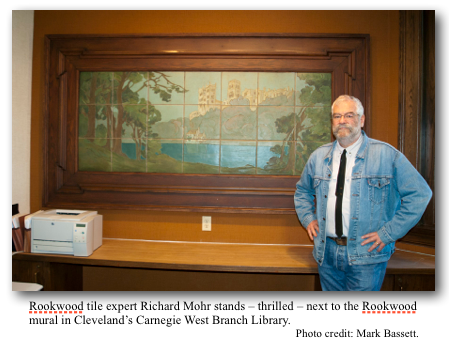
One could only get a glimpse of the mural through a glass panel in the door. Not even the building’s custodian had a key to the room.
Richard and Mark got lucky with the help of the children’s librarian, Helen Zaluckyj, who called ahead to the central administration downtown saying, “The experts have landed!” The key arrived and the mission accomplished. Read more...
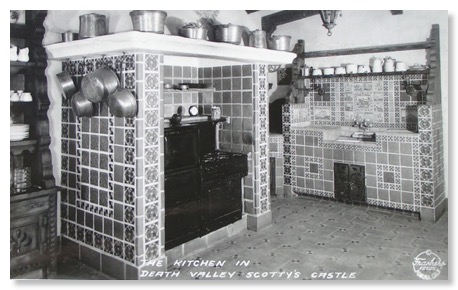
The Spanish Pottery
Circa 1927-1931
By Steven R. Soukup
The Spanish Pottery: its name alone evokes a romantic, old-world charm likely chosen to capitalize on the Mediterranean designs widespread in California; but of its history, much still remains a mystery. Along with Gladding McBean, Hispano Moresque and Alhambra Kilns this company was among the major suppliers of handcrafted tile outfitting the Death Valley ranch of Albert Johnson, now popularly known as Scotty’s Castle. How did an obscure tile company achieve this notable measure of success? Evidence points to the reputation and talent of its proprietor, Walter G. de Steiguer, formerly associated with Walter and Charles Nordhoff at California China Products Company. A Missouri native, de Steiguer was born in 1884.2 A mining engineer and geologist, he graduated from M.I.T.; going west around 1911 he found work heading the glaze department3 for the Nordhoffs in National City. As a young man of 27, here he would work alongside Fred Wilde, an older, accomplished tilewright and glaze specialist. De Steiguer stepped in to become vice-president of the operations when co-founder John McKnight left the company in 1912. There it is presumed he remained until the company ceased operations in 1917. His next few years remain sketchy, but in 19234 he is listed as Superintendent in the Tile Department at the Tropico Potteries, Inc.
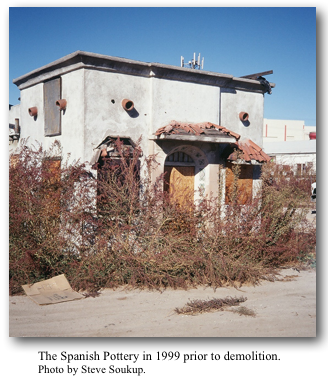
It is not yet clear when he hired on at Tropico, but he appears to have left by 1924 when he moved his residence from South Pasadena to Glendale, possibly to prepare for his next professional endeavor. Invoices dated between July 3, 1927 and May 24, 19315 confirm that by 1927, or perhaps earlier, he was fully in charge of The Spanish Pottery.
Manufacturers of plain and decorative glazed wall tile, red ware flooring tiles, ventilator tiles and specialties, The Spanish Pottery was located at 3959 Goodwin Avenue in Los Angeles, just west of Glendale. A tiny white stucco-clad and tile accented building6 remained on the site until recently: an abandoned witness to the past, lone amidst modern industry.
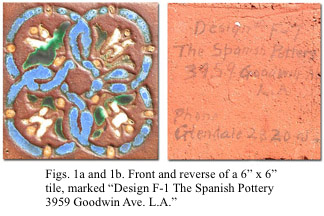
The company’s primary decorative product consisted of a series of red clay paver tiles and inserts, diverse to size and shape. The paver tiles appear to have their designs stamped by hand onto a wet clay slab before being cut into individual tiles; this could account for the characteristic “soft look” or lack of crisp mold definition frequently observed (Figs. 1a & 1b). The depressed designs were then inlaid with single or polychrome glazes. Finely decorated scenic tiles were commissioned including a tile panel series entitled El Miraje7 for a drinking fountain at Scotty’s Castle8. Similarly reminiscent of Spanish or Mexican folk pottery and executed in painterly fashion, small four-sided flowerpots were also produced along with large smoking stand tiles (Figs. 2a & 2b) fitted to wrought iron bases.
While de Steiguer was aptly qualified to oversee technical production and promote business, it is not known whether he also contributed artistically or relied on another designer. In absence of any large installations credited to The Spanish Pottery, exclusive of scattered installations at Scotty’s Castle, it is presumed that the small enterprise had limited production, which prematurely ended with the impending economic depression.
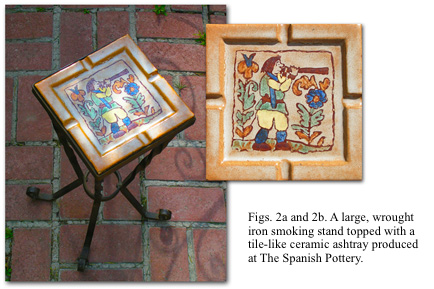
Twenty years later in 1950, Walter de Steiguer’s mystery novel titled Jewels for a Shroud was published9. The action in this work of pulp fiction takes place far from California, in New York City – “The big city slept while murder combed the causeways!” Unfortunately no biographical information regarding its author was included in the Dell paperback. For now this story ends; by late in life de Steiguer had returned to reside in his native Missouri10 notes here
VOLUNTEER! click on the image for details

E-News in Print
“Living Walls: Albany (NY)”
From Donald Shore, co-founder with Linda Ellett of L’esperance Tile Works
“This is the side of our building (at 237 Sheridan Avenue in Albany, New York, the original factory site of L’esperance Tile Works founded in 1979), tiled in September of 2011 by the graffiti artist Overunder, his first project using tile. If you follow the design, you will notice that the figure is a tile maker who is turning the t-handle of a stylized screw of a screw press.
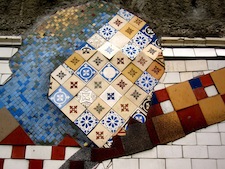
Notice the threads and the press plates. Behind this wall is the original L’esperance factory and the 1920's Hamilton tile press that we bought from Peter and Paula Cornelison at Fourth Bay some years ago. We are still producing tiles here; it’s our dust-pressed tile shop, 15% of which L’esperance occupies and the rest of the space shared with artists working in the ‘useful arts.’” The principle tile making facility is located in Rock City Falls, NY, a short distance north of Albany, where Overunder found all the tiles he needed in the L’esperance boneyard.
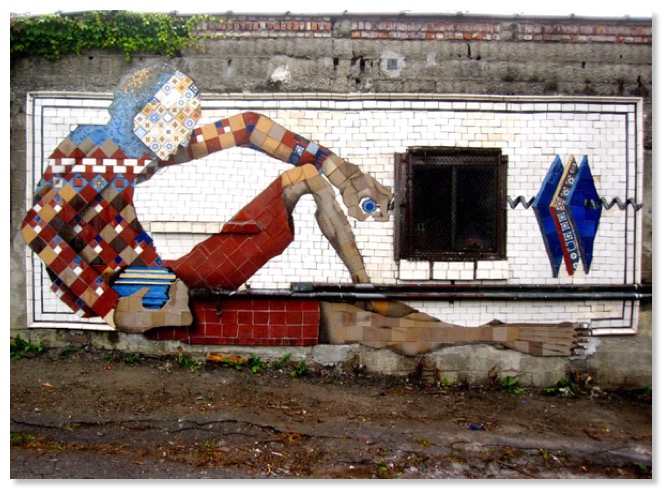
“He was standing in the pouring rain, digging through boxes of discards and overruns that he later brought with him to use in his Albany project,” Shore said. For an artist like Overunder, with such a fluid and free-wheeling figurative style with a spray can, it is surprising to see it interpreted with such permanence and cognitive consideration. According to Shore, Overunder “fell in love with the idea of tiles as a medium.” See more…
Payne Creations Chosen for Children’s Health Center
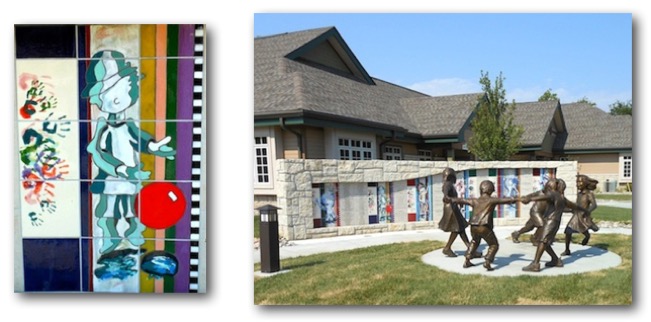
This past year tile artist Carolyn Payne was commissioned by the Salina Regional Health Foundation in Salina, Kansas to create three tile murals for the new Donna Vanier Children’s Center. The state-of-the-art center serves as home for three separate but inter-related children’s programs: Infant Care, Child Advocacy and Parenting Services, and Child Care.
After consulting with the architect and foundation, it was agreed for Payne to create three murals with the spirit of childhood: an exterior donor wall to recognize the major donors, an outside garden mural for the playground area, and an employee donor wall for the entrance to the Infant Child Development Program.
The outside donor wall adds color behind five bronze children figures. “I designed the children in a timeless fashion and love the colorful backdrop it creates.” There are close to 200 names on the 12” tiles in between the tile figures.
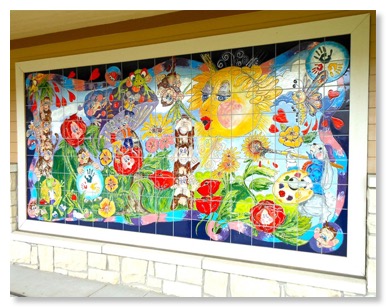
To create an outdoor playground mural artist Payne had to think like a child, so she created a brightly colored garden mural filled with monkeys, frogs, giant mushrooms, mice, rabbits, flowers with smiling faces and a grinning sun blowing out a gust of warm air onto the colorful landscape.
The employee donor wall (not shown) coordinates with the art theme in the building and consists of over 200 names of the employees that helped make the dream come true!
E-News in Print
JOIN TILE HERITAGE!

The galleon, No. 695 R, is illustrated in "Artistic Designs of Mantles using Faience and Araby Tiles," another Alhambra catalog published about the same time. Reproductions of these two catalogs are available through the Tile Heritage website. See catalogs
According to Norman Karlson in The Encyclopedia of American Art Tiles, the company was founded in 1901 by Otto Wolf and John Sheehy, with the latter gentleman as superintendent. Concerning the company's products, Karlson remarks that the pottery "was not a follower of all the latest trends." The company closed in 1941 and its facility was leased for war-related work. In 1942 the building burned to the ground and all the tile-related materials in storage were lost.
U.S. Historic Tile Installations
Board member Riley Doty was delighted recently to discover a trove of interesting historic tile material on a website maintained by THF member Michael Padwee of Brooklyn, New York. Riley asked Michael to write a few words about this ever-expanding resource and received this reply:
"About two years ago I discovered the historic landmarks website. The owner encouraged me to start a website about my interest—historic tile installations. I knew of a few installations existing in the New York area, and others that had been destroyed or had disappeared. I decided to research the installations, organize them by state, and share the information I found. One goal of this website is to locate and describe those installations that still exist but may not be well known, publicize them, and bring them to the attention of those who are interested in the preservation of historic tiles. Another goal is to document installations that have been destroyed and publicize the loss of our artistic heritage. I've received positive feedback and information about other installations from website visitors and hope that THF members will help also."
Here is a link to Michael's web site where 65 to 70 tile installations are described thus far. Michael has also started a blog, "Tiles in New York" as an adjunct to the website.
Presumably Gladding, McBean...


It can be a challenge identifying tiles, a service that we provide free at the Tile Heritage Foundation. Often we have to rely on experts, both collectors and historians, to reach a consensus. In fact, it’s the tiles we DON’T know that make our job interesting! Recently, Jennifer Wood, an estate appraiser in Santa Monica, California contacted us with several tile murals she needed identified. We had our suspicions but needed them confirmed. In this case we relied on the expertise of Steve Soukup and Scott Wells, who both agreed from the glaze colors and design elements that this particular equestrian was produced at the Gladding, McBean manufacturing plant on Los Feliz Boulevard in Glendale, formerly Tropico Potteries.

Hage’s Ice Cream Encountered
Well, let’s just say that in 1926 the soda fountain counter at Hage’s ice cream parlor in San Diego was “encrusted” with Calco tiles produced at the California Clay Products manufacturing plant in South Gate, California. We were able to identify the tiles using a magnifying glass on a 1931 black and white photograph that showed both corbels and snippets of decorative tiles behind the stools. At the time this type of tile was referred to in the U.S. as "faience" tile, tiles that were manufactured to look as if they were handmade. We never got to taste the ice cream as the parlor suffered a devastating fire in the 1980s. Today the home field of the San Diego Padres, Petco Park, occupies the site of what was once the largest independent ice cream shop on the West Coast. Read more...
Rookwood: Mission Impossible (nearly)
Tile historian, Richard Mohr, and Prof. Mark Bassett were on a mission recently to see firsthand a Rookwood mural at the Carnegie West Branch of the Cleveland Public Library. Two years ago when the American Art Pottery Association held its annual conference there, a tour group was stymied, finding the door to this interior sanctum closed and locked, alas inaccessible.

One could only get a glimpse of the mural through a glass panel in the door. Not even the building’s custodian had a key to the room.
Richard and Mark got lucky with the help of the children’s librarian, Helen Zaluckyj, who called ahead to the central administration downtown saying, “The experts have landed!” The key arrived and the mission accomplished. Read more...

The Spanish Pottery
Circa 1927-1931
By Steven R. Soukup
The Spanish Pottery: its name alone evokes a romantic, old-world charm likely chosen to capitalize on the Mediterranean designs widespread in California; but of its history, much still remains a mystery. Along with Gladding McBean, Hispano Moresque and Alhambra Kilns this company was among the major suppliers of handcrafted tile outfitting the Death Valley ranch of Albert Johnson, now popularly known as Scotty’s Castle. How did an obscure tile company achieve this notable measure of success? Evidence points to the reputation and talent of its proprietor, Walter G. de Steiguer, formerly associated with Walter and Charles Nordhoff at California China Products Company. A Missouri native, de Steiguer was born in 1884.2 A mining engineer and geologist, he graduated from M.I.T.; going west around 1911 he found work heading the glaze department3 for the Nordhoffs in National City. As a young man of 27, here he would work alongside Fred Wilde, an older, accomplished tilewright and glaze specialist. De Steiguer stepped in to become vice-president of the operations when co-founder John McKnight left the company in 1912. There it is presumed he remained until the company ceased operations in 1917. His next few years remain sketchy, but in 19234 he is listed as Superintendent in the Tile Department at the Tropico Potteries, Inc.

It is not yet clear when he hired on at Tropico, but he appears to have left by 1924 when he moved his residence from South Pasadena to Glendale, possibly to prepare for his next professional endeavor. Invoices dated between July 3, 1927 and May 24, 19315 confirm that by 1927, or perhaps earlier, he was fully in charge of The Spanish Pottery.
Manufacturers of plain and decorative glazed wall tile, red ware flooring tiles, ventilator tiles and specialties, The Spanish Pottery was located at 3959 Goodwin Avenue in Los Angeles, just west of Glendale. A tiny white stucco-clad and tile accented building6 remained on the site until recently: an abandoned witness to the past, lone amidst modern industry.

The company’s primary decorative product consisted of a series of red clay paver tiles and inserts, diverse to size and shape. The paver tiles appear to have their designs stamped by hand onto a wet clay slab before being cut into individual tiles; this could account for the characteristic “soft look” or lack of crisp mold definition frequently observed (Figs. 1a & 1b). The depressed designs were then inlaid with single or polychrome glazes. Finely decorated scenic tiles were commissioned including a tile panel series entitled El Miraje7 for a drinking fountain at Scotty’s Castle8. Similarly reminiscent of Spanish or Mexican folk pottery and executed in painterly fashion, small four-sided flowerpots were also produced along with large smoking stand tiles (Figs. 2a & 2b) fitted to wrought iron bases.
While de Steiguer was aptly qualified to oversee technical production and promote business, it is not known whether he also contributed artistically or relied on another designer. In absence of any large installations credited to The Spanish Pottery, exclusive of scattered installations at Scotty’s Castle, it is presumed that the small enterprise had limited production, which prematurely ended with the impending economic depression.

Twenty years later in 1950, Walter de Steiguer’s mystery novel titled Jewels for a Shroud was published9. The action in this work of pulp fiction takes place far from California, in New York City – “The big city slept while murder combed the causeways!” Unfortunately no biographical information regarding its author was included in the Dell paperback. For now this story ends; by late in life de Steiguer had returned to reside in his native Missouri10 notes here
VOLUNTEER! click on the image for details

E-News in Print
Send Tile Heritage your ‘Tile Tales” Share pictures of interesting installations both historic and contemporary as well as restorations and other tile treasures! Submission guide lines
“Living Walls: Albany (NY)”
From Donald Shore, co-founder with Linda Ellett of L’esperance Tile Works
“This is the side of our building (at 237 Sheridan Avenue in Albany, New York, the original factory site of L’esperance Tile Works founded in 1979), tiled in September of 2011 by the graffiti artist Overunder, his first project using tile. If you follow the design, you will notice that the figure is a tile maker who is turning the t-handle of a stylized screw of a screw press.

Notice the threads and the press plates. Behind this wall is the original L’esperance factory and the 1920's Hamilton tile press that we bought from Peter and Paula Cornelison at Fourth Bay some years ago. We are still producing tiles here; it’s our dust-pressed tile shop, 15% of which L’esperance occupies and the rest of the space shared with artists working in the ‘useful arts.’” The principle tile making facility is located in Rock City Falls, NY, a short distance north of Albany, where Overunder found all the tiles he needed in the L’esperance boneyard.

“He was standing in the pouring rain, digging through boxes of discards and overruns that he later brought with him to use in his Albany project,” Shore said. For an artist like Overunder, with such a fluid and free-wheeling figurative style with a spray can, it is surprising to see it interpreted with such permanence and cognitive consideration. According to Shore, Overunder “fell in love with the idea of tiles as a medium.” See more…
Payne Creations Chosen for Children’s Health Center

This past year tile artist Carolyn Payne was commissioned by the Salina Regional Health Foundation in Salina, Kansas to create three tile murals for the new Donna Vanier Children’s Center. The state-of-the-art center serves as home for three separate but inter-related children’s programs: Infant Care, Child Advocacy and Parenting Services, and Child Care.
After consulting with the architect and foundation, it was agreed for Payne to create three murals with the spirit of childhood: an exterior donor wall to recognize the major donors, an outside garden mural for the playground area, and an employee donor wall for the entrance to the Infant Child Development Program.
The outside donor wall adds color behind five bronze children figures. “I designed the children in a timeless fashion and love the colorful backdrop it creates.” There are close to 200 names on the 12” tiles in between the tile figures.

To create an outdoor playground mural artist Payne had to think like a child, so she created a brightly colored garden mural filled with monkeys, frogs, giant mushrooms, mice, rabbits, flowers with smiling faces and a grinning sun blowing out a gust of warm air onto the colorful landscape.
The employee donor wall (not shown) coordinates with the art theme in the building and consists of over 200 names of the employees that helped make the dream come true!
E-News in Print
JOIN TILE HERITAGE!
Send Tile Heritage your ‘Tile Tales’ - Share pictures of interesting installations both historic and contemporary as well as restorations and other tile treasures! Submission guide lines
See who Sponsors Tile Heritage Foundation
Link to E-News prior to Spring 2010

